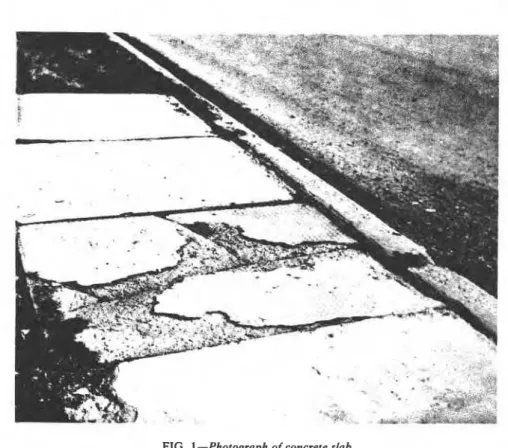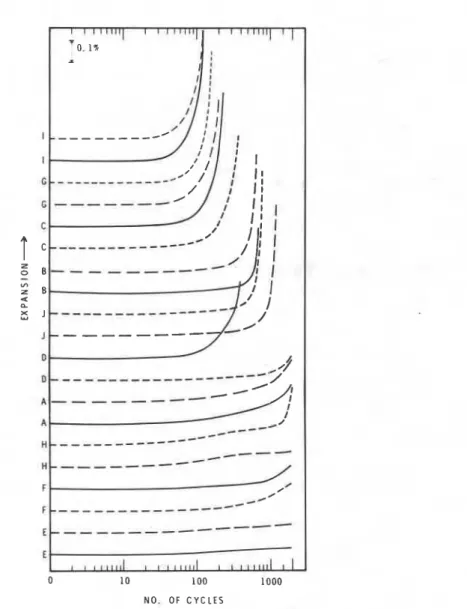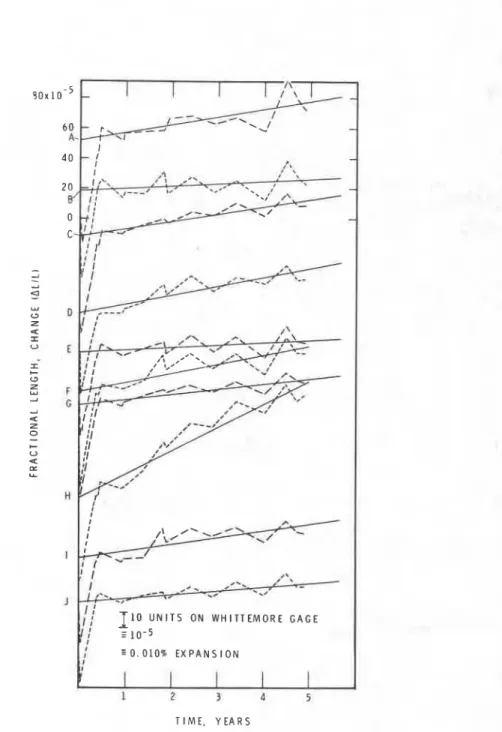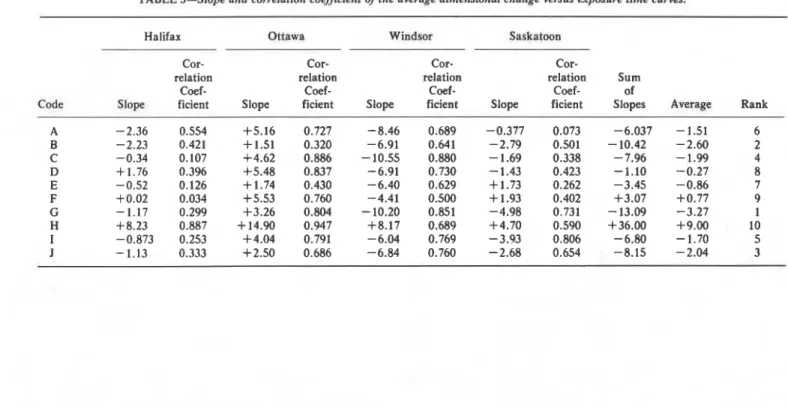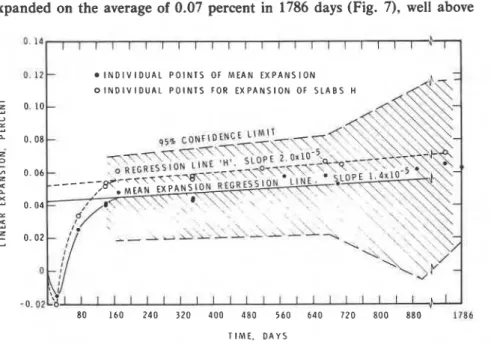Publisher’s version / Version de l'éditeur:
ASTM Special Technical Publication, 691, pp. 560-573, 1980
READ THESE TERMS AND CONDITIONS CAREFULLY BEFORE USING THIS WEBSITE. https://nrc-publications.canada.ca/eng/copyright
Vous avez des questions? Nous pouvons vous aider. Pour communiquer directement avec un auteur, consultez la première page de la revue dans laquelle son article a été publié afin de trouver ses coordonnées. Si vous n’arrivez pas à les repérer, communiquez avec nous à PublicationsArchive-ArchivesPublications@nrc-cnrc.gc.ca.
Questions? Contact the NRC Publications Archive team at
PublicationsArchive-ArchivesPublications@nrc-cnrc.gc.ca. If you wish to email the authors directly, please see the first page of the publication for their contact information.
NRC Publications Archive
Archives des publications du CNRC
This publication could be one of several versions: author’s original, accepted manuscript or the publisher’s version. / La version de cette publication peut être l’une des suivantes : la version prépublication de l’auteur, la version acceptée du manuscrit ou la version de l’éditeur.
Access and use of this website and the material on it are subject to the Terms and Conditions set forth at
Cooperative test program for precast concrete paving elements
Litvan, G. G.; MacInnis, C.; Grattan-Bellew, P. E.
https://publications-cnrc.canada.ca/fra/droits
L’accès à ce site Web et l’utilisation de son contenu sont assujettis aux conditions présentées dans le site LISEZ CES CONDITIONS ATTENTIVEMENT AVANT D’UTILISER CE SITE WEB.
NRC Publications Record / Notice d'Archives des publications de CNRC:
https://nrc-publications.canada.ca/eng/view/object/?id=45a558ab-19b4-485e-933b-10194c1a6e91 https://publications-cnrc.canada.ca/fra/voir/objet/?id=45a558ab-19b4-485e-933b-10194c1a6e91G. G . Litvan.
'
Cameron MacInnis, and
P. E.
Grattan-Bellewl
Cooperative Test Program for
Precast Concrete Paving Elements
R E W C E : Litvan. G. G.. MacInnis. Cameron. and Grottan-Bellcw. P. E.,
''&opedm Tat Pmgmm for Pnart thcm& Ekmmb." Durability of Building Materials and Components. ASTM STP 691. P. J. Screda and G. G. Ljtvan.
Eds.. American Society for Testing and Materials. 1980. pp. 560-573.
AEWWAmt Conmete w a g slabs rm tatsd to Khkrr the fdlowing thra objectira: (1) assess the dqtrse of freeze-thaw durability required in the various climatic regions of Canada. (2) assess the merit d standard testing methods, and (3) evaluate the adequacy bf commercial products. Rautts indicated that: the amount of salt used for the same area at the various sites differs greatly (3 kg in Saskatwn. 277 kg in Ottawa); the moisture content. regardless of the season, is close to saturation (rclatht humidity 87 percent): neither the standard q c l i u l Wing-thawing nor the standard salt-scaling tests yieM representative mb; all the commercial products, with one exception. could be judged durable.
KJ3Y WORDS: concrete, precast concrete. pressed mcrete, paving slabs, building materi.h. durability, freezing and thawing, salt scaling, alkali-aggregate reactivity
For satisfactory service in Canada, precast concrete paving slabs are required to have a very high degree of resistance against the action of freezing and thawing in the presence of deicing salts. To satisfy this requirement, manufacturers of such products face a difficult task.
Matters are made more complicated by the diverse conditions prevailing in' the various regions of the country: the relatively temperate Atlantic Provinces; the dry, cold Prairie. Provinces; and the variable but severe climate around the Great Lakes. Obviously, not the same durability is required in the various regions.
Not only are these requirements ill defined but there is no agreement concerning the testing method. Because of these uncertainties, the adequacy of the slabs now manufactured cannot be evaluated.
'Senior mearch officer and associate research o f f i . mpcctivcly. Division of Building Research. National Research Council of Canada. Ottawa. Ontario. Canada.
Z ~ e a n d Engineering. Department of Civil Engineering. University of Windsor. Windsor. Ont.. Caub..
LITVAN ET AL ON TEST PROGRAM FOR PAVING ELEMENTS 561
The pertinent Canadian,?Standards % : & * > a -a&~oQc;iatign, (CSA) Standard for
Precast Concrete Paving Slabs ( C S ~ x231'.fll$72)' states, "The man- ufacturer shall satisfy the purchaser either by proven field performance, or the laboratory salt-scaling test, that the paving slabs have adequate durability." Field performance is considered to be satisfactory if no objectionable deterioration ?eqirs after 3 years of exposure. The laboratory salt-scaling test consists of ktpo&ng the specimen, with a salt solution ponded on the surface, to r&kated cycles of freezing and thawing (CSA A231.1). ""
At the request of the National Precast Concrete Association, the National Research Council (NRC), in cooperation with the University of Windsor, initiated the present project in 1972 with the following objectives:
1. assess the degree of freeze-thaw resistance necessary for good per- formance in the various clim'atic regions of Canada,
2. evaluate the merit of the various methods for testing the freeze-thaw resistance of precast concrete elements, and
3. evaluate the adequacy of the products of manufacturers in various regions of Canada.
Materials
In the summer of 1972, seven manufacturers supplied 144 precast paving slabs from their current production. These were either "wet pressed" using Fielding machines, or "dry impacted" using a Rino machine, or cast in molds. In addition, for purposes of comparison, 40 slabs were cast in molds at NRC. There were altogether ten different types of slabs, each nominally 762 by 610 by 51 mm (30 by 24 by 2 in.). They were coded with letters from A to J. Slabs,A, D, E, and H were cast and air entrained; B, C, G , I, and J were wet pressed; and Slab F dry pressed.
yield Exposure
.
* .The specimen slabs were exposed at four sites: Halifax, Nova Scotia, at the Nova Scotia Technical College; Saskatoon, Saskatchewan, at the exposure site of the Prairie Regional Laboratory of the NRC of Canada; Windsor, Ontario, at the University of Windsor Campus; and in Ottawa on the NRC grounds.
Stainless steel studs, cemented in the slabs with epoxy cement prior to exposure, facilitated length change measurements in the field with a Huggenberger gage. The slabs were placed on a 50 mm deep sand base in random sequence with their top surface being approximately level with the surrounding ground. With the exception of the Saskatoon site, the slabs formed sections of existing walkways that were subjected to considerable pedestrian traffic.
562 DURABILITY OF BUILDING MATERIALS AND COMPONENTS
During the winter the walkways were cleaned of snow and salted when icing conditions prevailed. The amount of salt (NaCI) applied was recorded (Table 1).
The results, though incomplete, clearly show the vast differences that exist with respect to climatic conditions among the various Canadian geographic regions. The ratio of the quantities of salt applied at Saskatoon, Windsor, Halifax and Ottawa is 1 : 1526: 101. Although salt consumption cannot be accepted as the sole measure of severity, it is certainly one of the major factors. It is a well known fact that, in the presence of deicing salts, damage due to frost action is increased. The relatively cold but changeable Ottawa climate is the most damaging from the salt scaling point of view, an indication consistent with field experience.
In addition to the NRC site, ten slabs were exposed in Ottawa on a city street, forming the curbside section of the sidewalk at a bus stop. Un- fortunately, after the first winter exposure, the city paved the street and the specimens were lost. Even in this short period of time, however, the slabs suffered much deterioration as can be seen in the photograph taken in March (Fig. 1). The combined effect of the mechanical damage inflicted by the snow-clearing equipment, the buses, and the frequent splashing of brine must have caused the failure of the slabs. The sharply differing performance of the same type of slabs at two locations in Ottawa under- lines the importance of the local environment as well as the material when evaluating durability. It is quite common to classify a material in itself as durable without specifying the limiting environmental conditions.
Adsorption Isotherm
To establish the relationship between moisture content and relative humidity, two specimens (100 by 100 mm-base) were cut from each type of slab and exposed to carefully controlled humidities in a glove box. The relative humidity was continuously monitored with an Aminco hygrometer; the variation was less than + 1 percentage point. Change in moisture content was determined inside the glove box. Time required to reach equilibrium at a given humidity level was approximately 22 weeks.
TABLE 1- Yearly salt consumption, kg, at the exposure sites.
1972-1973 1973-1974 1974-1975 1975-1976 1976-1977 Total Halifax 20.9 8.2 .
. .
a 19.1 23.6 71.8 Windsor 8.2. .
. a 16.3 10.0 8.2 42.7 Ottawa 72.6 61.3 25.0 74.9 43.1 276.9 Saskatoon 0.0 2.7 0.0 0.0 0.0 2.7 'Not available.LIWAN ET AL ON TEST PROGRAM FOR PAVING ELEMENTS 563
FIG. 1 -Photograph of concrete slab.
The isotherms shown in Fig. 2 exhibit marked hysteresis. The first adsorption path (Points 1, 2, and 3) was not retraced in the second path (Points 5, 6, and 7). Similar deviation was found with respect to other points. The total uptake varies from 3.15 (Specimen C) to 5.45 weight percent (Specimen
H),
the average for the ten types being 4.1 percent. Moisture Content of Exposed SpecimensTo obtain information on the moisture content of the exposed slabs, specimens of each type were cut (with 100 by 100 mm base), the sides covered with an epoxy coating and placed on a 50 mm thick sand bed in the field in the same general area as the slabs. The variation of moisture content was determined by weighing at periodic intervals, at least twice a year. Four specimens of each type were exposed; the averages of the weight changes are shown in Fig. 3. The values were corrected for weight loss due to spalling. A portion of the epoxy coating and in some instances chips of the concrete fell off, mainly during the first year. In spite of the
564 DURABILITY OF BUILDING MATERIALS AND COMPONENTS,
I
I I L I I I I II
I
I
I
1
1
I
l
)
20 40 60 80 100 20 40 60 80 100
PERCENT RELATIVE HUMIDITY
FIG. 2.-Adsorption isotherm ofspecimens.
great care taken, the correction cannot be considered as completely successful and the initial section of the curves may be incorrect.
There is, however, little uncertainty about the later and final section of the curves which indicate essentially no change in moisture content for all ten types of specimens. Because the weight changes could not be monitored continuously, between measurements undetected transitory changes may occur but this is not very probable. From the level reached after 4 years, the average moisture condition to which the specimens are exposed can be
LITVAN ET AL ON TEST PROGRAM FOR PAVING ELEMENTS
565
I -I---
----____
--___---
,)'/--..---
---
, / - - - _ _ _ _ _ f _ _ _ _ _ _ - _ _ _ _ _ - - - _ _ * _ _ _ _ _ ---+---
,_----
---__
---_--
..---
r - - - _ _ _ - - _ _ _ _ C _ _ - - - _ _ _ _ _ - - -- -
/ - - ----
/./
/7
= 2% W E I G H T G A I N I b W I O R I G . W T . ) i I I I I 0 I 2 3 4 T I M E . Y E A R SFIG. 3-A verage of moisture content variation of field-exposed specimens.
estimated with the aid of the adsorption isotherms (Fig. 2). The values of Table 2 indicate that, regardless of the season, the moisture condition is equivalent to a relative humidity of 87 percent.
Cyclical Freezing and Thawing Test
Two specimens, 25 cm long and 7.5 cm wide, were cut from each type of slab and tested in accordance with ASTM Test for Resistance of Concrete to Rapid Freezing and Thawing (C 666
-
77) (freezing in air, thawing in water). The apparatus and procedure conformed to the standard; afterTABLE 2-Moisture gain. after 4 years of exposure. related to relative humidity. Gain
Relative
Code Weight, % Average Humidity
A 2.5, 2.5, 2.6, 2.3 2.45 88 B 3.0, 3.3, 2.9. 3.9 3.27 90.5 C 2.8, 2.6, 2.4. 2.2 2.50 88 D 1.5, 2.0, 2.7. 2.5 2.17 83 E 2.6. 2.5. 2.5, 2.7 2.57 89 F 2.7, 2.5, 2.7. 2.8 2.67 89 G 1.5, 1.8, 1 .S, 1.8 1.65 80 H 4.2. 4.1, 4.4. 4.4 4.27 90 I 2.5. 2.5. 1.8. 2.4 2.30 85 J 2.5. 2.3, 2.5. 2.7 2.50 88 Average 2.63 87
566 DURABILITY OF BUILDING MATERIALS AND COMPONENTS
having reached the temperature at the specified rate, it was kept constant
so that each half cycle lasted 6 h. Degradation of the specimens was
assessed from residual length change m e a ~ u r e m e n t . ~ Figure 4 shows the
change of residual length change as a function of cycle number. The following comments may be made:
(a) All specimens show detectable expansion (AL = 0.005 percent) at
fewer than 100 cycles. This is consistent with earlier findings according to which residual length change measurement is a reliable and sensitive method for detecting frost damage.
( 6 ) In some instances the agreement between duplicate specimens was rather poor.
Salt-Scaling Test
The ten slabs were subjected to the CSA Standard A231.1 in which the 'specimen is frozen and thawed 50 times with a salt solution ponded on the
surface. The results are shown in Fig. 5.
Dimensional Changes
Changes in the dimensions of the slabs exposed at the four sites were
determined, as described in the previous section. Extension curves obtained
from results of the slabs exposed in Ottawa are shown in Fig. 6. In Table 3,
the slopes of the curves of specimen slabs at all sites are given.
Discussion
1. With the exception of those exposed at the Ottawa site, the exposed
specimens showed no sign of any distress after five winters. On this basis all the products have to be judged as durable. This is surprising and inconsistent with the cyclical freeze-thaw test in which at least three types
of slabs, I, G , and C, were found to be susceptible to frost by deteriorating
after fewer than 250 cycles (Fig. 4). Significantly, according to the salt-
scaling test, C is the best; I and G are relatively good. Although this test
showed that Slabs B, A, and E were the most prone to the action of
deicing salts, in the freezing and thawing test E was the best and A was among the best. According to the salt-scaling test, by far the most sus-
ceptible to the action of deicing salts is Specimen B, which showed signs
of deterioration after 200 freezing and thawing cycles carried out in
accordance with the test in ASTM Method C 666. According to the
LITVAN ET AL ON TEST PROGRAM FOR PAVING ELEMENTS 567
N O . O F C Y C L E S
FIG. 4-Expansion of patio slab sections as a function of freeze-thaw cycles.
dimensional changes of the exposed slabs at all sites, the B slabs per- formed among the best (Fig. 6 and Table 3).
The freezing and thawing test, and to a greater extent the salt-scaling test, are noted for yielding easily reproducible and very representative results. Owing to the scarcity of long-term performance studies, the size of the discrepancy between predicted and actual field performance is not generally recognized. In connection with the large-scale Naperville Farm
568 DURABILITY OF BUILDING MATERIALS AND COMPONENTS
N O . O F C Y C L E S
FIG. 5-CSA salt scaling test.
program of the Portland Cement Association, in which concrete specimens were tested in two different laboratories and exposed, T. C. Powers pointed out4: "During these laboratory tests every specimen was damaged, some much more than others. These tests gave no indication that of more than
1000 specimens exposed out of doors, 87 percent would remain undamaged after more than 20 years of outdoor exposure."
The results of this present study are fully consistent with these observa- tions. On the basis of the tests, at least three slabs should have been judged unacceptable on the basis of one test and another three on the basis of the other test. It appears that the best products in the lot would have been eliminated by this process.
It can then be concluded that the results of the conventional tests bear
LITVAN ET AL ON TEST PROGRAM FOR PAVING ELEMENTS 569 1 1 0 U N I T S O N W H l l l E M O R E G A G E 1 0 - 5
I
( j ' 0 . 0 1 0 1 E X P A N S I O NI
1 2 3 D 5 T I M E , Y E A R S0
C
n
9
m
TABLE 3-Slope and correlation oaefflcient of the m m g e dimerwbm~nl change vcrsur eyp08ure time c u m .
5
Halifax Ottawa Windsor Saskatoon
8
m
c
Cor- Cor- Cor- Cor- r
relation relation relation relation Sum 0
Coef- Coef- Coef- Coef- of C )
z
Code Slope ficient Slope ficient Slope ficient Slope ficient Slopes Average Rank
I A -2.36 0.554 +5.16 0.727 -8.46 0.689 -0.377 0.073 -6.037 -1.51 6
5
B -2.23 0.421 +1.51 0.320 -6.91 0.641 -2.79 0.501 -10.42 -2.60 2 rn-
n C -0.34 0.107 +4.62 0.886 -10.55 0.880 -1.69 0.338 -7.96 -1.99 4 9 D +1.76 0.396 +5.48 0.837 -6.91 0.730 -1.43 0.423 -1.10 -0.27 85
E -0.52 0.126+
1.74 0.430 -6.40 0.629 +1.73 0.262 -3.45 -0.86 7 D F +0.02 0.034 +5.53 0.760 -4.41 0.500 +1.93 0.402 +3.07 +0.77 9 Z G -1.17 0.299 +3.26 0.804 -10.20 0.851 -4.98 0.731 -13.09 -3.27 1 0 H +8.23 0.887 +14.90 0.947 +8.17 0.689 +4.70 0.590 +36.00 +9.00 10 0 I -0.873 0.253 +4.04 0.791 -6.04 0.769 -3.93 0.806 -6.80 -1.70 5 0 J -1.13 0.333 +2.50 0.686 -6.84 0.760 -2.68 0.654 -8.15 -2.04 3LITVAN ET AL ON TEST PROGRAM FOR PAVING ELEMENTS 571
little relation to actual performance and the procedures appear to be far too severe.
2. The dimensions of an exposed slab will be altered by thermal effects, change in moisture content, and change in mechanical properties due to hydration, freezing and thawing, and alkali reactivity.
In the present investigation, thermal effects can be disregarded because the results were obtained, to the utmost extent possible, at the same temperature. Measurements were made at the same time of the season on days when the air and surface temperatures reached predetermined values. As the slabs had been stored indoors, their moisture content at the outset of exposure was low and the initial expansion shown in Fig. 6 must be ascribed to wetting. This is consistent with the increase of moisture content indicated by the curves of Fig. 3. As stated earlier, the moisture content after the initial period was found to be constant and of a level which is normally produced by exposure to 87 percent relative humidity of the slabs. Constant moisture content does not preclude redistribution between free and bound water as hydration proceeds, as was shown by the
contraction of the specimens at sites other than Ottawa (Table 3). Expansions
indicated by the curves in Fig. 6 should then be attributed to either frost damage or alkali reactivity.
By far the largest expansion at all sites occurred in Specimen H. Examina- tion of the dimensional changes at the Ottawa site shows that H slabs expanded on the average of 0.07 percent in 1786 days (Fig. 7), well above
I N D I V I D U A L P O I N T S O F M E A N E X P A N S I O N O l N O l V l D U A L P O I N I S F O R E X P A N S I O N O F S L A B S H
T I M E . D A Y S
FIG. 7-Mean expansion ojall the patio slabs on the walk at NRC Ottawa (His also shown
572
DURABILITY OF BUILDING MATERIALS AND COMPONENTS,the mean regression line of all the slabs. Specimens of Slab H were found to be highly frost resistant by alternate freezing and thawing test but failed in the salt ponding test. In light of what has been said, these results offer little guidance as to the cause of the expansion.
A modified version of the concrete prism test (CSA Standard for Alkali Aggregate Reaction A23.2-14A), was used to ascertain the alkali reactivity of the aggregates in the slabs. Because aggregates used in the fabrication of the slabs were not available for each type, prisms were sawn from the slabs which had been stored indoors for 3 years.
According to the results of the concrete prism test shown in Fig. 8, Specimen H expanded 0.127 percent in 3 years; this is well outside the 95 percent confidence limits of the mean expansion of all the patio slabs excluding H. This expansion, which is greater than that found with the field-exposed specimen, together with the marked map cracking leaves little doubt about the reactivity of the aggregate in Slab H.
0 . 1 6
NOTE
0 14
-
P O I N T S LABELED W I T H LETTERS I N D I C A T E THE E X P A N S I O N OFI N D I V I D U A L P R I S M S EACH P O I N T I S THE AVERAGE OF TWO P R I S M S
.-
H -e--- ---b---b41
L
0 1 2 -__----
o----(L---
W U d o - - - - P: W - _ * - - - - a. 0 . 1 0-
I.*0- + 0,- 0!/I
SO 1 6 0 240 320 4 0 0 4 8 0 5 6 0 6 4 0 7 2 0 8 0 0 8 8 0 1168 T I M E . D A Y S . AT 100% R . H . A N 0 38'CFIG. 8-Mean expansion of prisms cut from patio slabs (tested according to modified concrete prism test CSA A23-2-24).
Conclusions
The following tentative conclusions have been reached:
1. From the point of view of frost action Ottawa is the most severe region of the four exposure sites. Halifax (Maritime), Saskatoon (Prairie), and Windsor are far less severe.
LITVAN ET AL ON TEST PROGRAM FOR PAVING ELEMENTS
573
2. The conventional laboratory tests, under conditions prevailing in the present program, yielded predictions which show little, if any, agreement with actual field performance.
3. The moisture content of the exposed slabs is fairly constant and is of the level that normally occurs at exposures at 87 percent relative humidity.
4. All slabs, except H, are durable.
